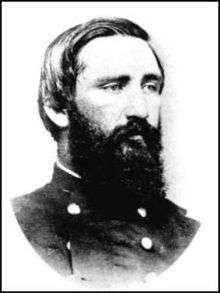William P. Sanders
| William Price Sanders | |
|---|---|
 | |
| Born |
August 12, 1833 near Frankfort, Kentucky |
| Died |
November 19, 1863 (aged 30) Knoxville, Tennessee |
| Place of burial | Chattanooga National Cemetery, Chattanooga, Tennessee |
| Allegiance |
United States of America Union |
| Service/branch |
United States Army Union Army |
| Years of service | 1856–1863 |
| Rank |
|
| Battles/wars | American Civil War |
William Price Sanders (August 12, 1833 – November 19, 1863) was an officer in the Union Army in the American Civil War, who died at the Siege of Knoxville.
Birth and early years
William Sanders was born near Frankfort, Kentucky to wealthy attorney Lewis Sanders (Saunders), Jr., (born circa 1797) and his wife Margaret H. Sanders (born circa 1804). His family moved circa 1839 to Natchez, Mississippi, where he was raised. He was a cousin of Jefferson Davis, and his sister Elizabeth Jane married attorney, mining magnate and thoroughbred horse breeder James Ben Ali Haggin (December 9, 1822 – September 13, 1914), a business partner of George Hearst and the owner of Elmendorf Farm in Lexington, Kentucky. The Haggin family lived next door to the Sanders family in Natchez.[1] William Price Sanders went by the nickname "Doc", but he did not have a medical degree. He was purportedly named in honor of his uncle, a physician. NOTE: Presumably Lewis Bennett P. Sanders, M.D.[2]
Military career
Sanders attended the United States Military Academy at West Point from 1852 to 1856, but was not an outstanding cadet, graduating 41st in his class. West Point Superintendent Robert E. Lee wrote a May 1854 letter announcing Sanders' dismissal, but he managed to avoid dismissal with the help of the U.S. Secretary of War Jefferson Davis. Sanders graduated in 1856, and served in the western territories (including Utah). He was commissioned a brevet second lieutenant in the 1st U.S. Dragoons on July 1, 1856. He became second lieutenant in the 2nd U.S. Dragoons on May 27, 1857.
Despite a pre-war reputation for being sympathetic to the South, Sanders remained loyal to the Union. He was promoted to first lieutenant on May 10, 1861. Four days later he was raised to the rank of captain. On August 2, 1861, the 2nd U.S. Dragoons was renamed the 6th U.S. Cavalry, where he participated in the Peninsula Campaign and the Battle of Antietam. After Antietam, Ambrose Burnside gave him a command in the Department of the Ohio, resulting in his transfer to Cincinnati, Ohio. Burnside then decided to have Sanders lead a raid into East Tennessee, where he was to scout out the enemy, as well as disrupt communication and transportation networks. He also pursued Morgan's Raiders. Sanders later returned to Kentucky, where he was promoted to brigadier general on October 18, 1863, although this appointment was never confirmed by the Senate.[3]
Sanders next moved with his forces to Knoxville, where he arrived September 3, 1863. On November 18, Sanders was shot in the side by forces under the command of Confederate Col. Edward Porter Alexander, his old roommate and classmate at West Point. The sharpshooter is believed to have been in the tower of Bleak House. Sanders was taken to the Lamar House, where he died the next day.
Sanders was initially buried in the cemetery of Second Presbyterian Church under cover of darkness, but his remains were later moved to the Chattanooga National Cemetery. He was a bachelor at the time of his death, but was dating Sue Boyd, a Knoxville relative of Confederate spy Belle Boyd. Miss Boyd is not believed to have betrayed him, and is reported to have mourned his death.
The Battle of Fort Sanders, part of the Knoxville Campaign, occurred approximately ten days after his death.
Namesakes and honors
The Union fortification "Fort Loudon" was renamed "Fort Sanders" in his memory. Knoxville's Fort Sanders neighborhood and Fort Sanders Presbyterian Hospital, both of which are located on the site of the fort, are also named after him. In addition, the Sons of Union Veterans has a chapter in East Tennessee named in memory of "Colonel William P. Sanders". A historic marker on Kingston Pike denotes the location where he was mortally wounded. Ironically, the marker is on the property of Second Presbyterian Church, which relocated from downtown Knoxville to the place where William Sanders was hit.
See also
Notes
References
- Alexander, Edward P. and Gallagher, Gary W. (editor), Fighting for the Confederacy: The Personal Recollections of General Edward Porter Alexander, University of North Carolina Press, 1989, ISBN 0-8078-4722-4.
- Eicher, John H., and Eicher, David J., Civil War High Commands, Stanford University Press, 2001, ISBN 0-8047-3641-3.
- Heitman, Francis, Historical Register and Dictionary of the United States Army 1789-1903. (US Government Printing Office, Washington, 1903).
- Law Notice, The Louisianan and Journal of Commerce, New Orleans, Louisiana, February 4, 1839
- Kentucky State Historical Society, Volume 41, Number 134, January 1943, pages 44–62 (Leavy, William A. Part Four: A Memoir of Lexington and Its Vicinity)
External links
- Sanders Bio
- Sanders Photos at the Wayback Machine (archived February 8, 2008)
- Union General's Stats: Sanders
- Antietam on the Web: Sanders
- Ohio 45th Battle Account
- Loudon Co. Campaign
- Bleak House Sharpshooter
- 2nd Presbyterian Church History
- Louisianian Law Notice